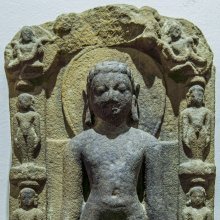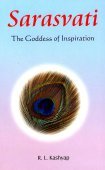Jainism: 6 definitions
Introduction:
Jainism means something in Buddhism, Pali, Hinduism, Sanskrit, Jainism, Prakrit, the history of ancient India. If you want to know the exact meaning, history, etymology or English translation of this term then check out the descriptions on this page. Add your comment or reference to a book if you want to contribute to this summary article.
Images (photo gallery)
In Hinduism
Vaishnavism (Vaishava dharma)
Source: Pure Bhakti: Bhagavad-gita (4th edition)Jainism (जैनिस्म्) refers to “a religious movement begun many hundreds of years ago by King Arhat. The strict followers of Jainism idealistically try to emulate Mahārāja Ṛṣabhadeva by practising non-violence and by not using vehicles. Ṛṣabha was an avatāra of Śrī Kṛṣṇa, whose history is described in the Fifth Canto of Śrīmad-Bhāgavatam”. (cf. Glossary page from Śrīmad-Bhagavad-Gītā).

Vaishnava (वैष्णव, vaiṣṇava) or vaishnavism (vaiṣṇavism) represents a tradition of Hinduism worshipping Vishnu as the supreme Lord. Similar to the Shaktism and Shaivism traditions, Vaishnavism also developed as an individual movement, famous for its exposition of the dashavatara (‘ten avatars of Vishnu’).
In Buddhism
General definition (in Buddhism)
Source: Buddhist Door: GlossaryA religion founded by Nataputta, who was a royal clan of the Nata tribe in ancient India at the time of Shakyamuni. Similar to Buddhism, its basic doctrine is non materialistic atheism.In Jainism
General definition (in Jainism)
Source: Jain eLibrary: 7th International Summer School for Jain StudiesJainism:—The word Jain is derived from the word jina (spiritual conqueror). Jina is a perfect human being who has attained pure soul state associated with the four primary qualities namely infinite perception-knowledge-energy and bliss. He is an ordinary human being at the time of birth but through his strenuous spiritual purification efforts, he attains this state. Followers of the path shown by Jina are called Jains.

Jainism is an Indian religion of Dharma whose doctrine revolves around harmlessness (ahimsa) towards every living being. The two major branches (Digambara and Svetambara) of Jainism stimulate self-control (or, shramana, ‘self-reliance’) and spiritual development through a path of peace for the soul to progess to the ultimate goal.
India history and geography
Source: archive.org: Social Life In Medieval RajasthanJainism in Rājasthān.—Jainism was a popular and living religion and was followed by trading classes, wealthy sections of the society. Jainism had gained a firm footing here (in Rājasthān) since the early part of the 10th century A.D. It also seems that progress of Jainism in this part of the country was largely due to the efforts of celebrated Jaina monks of various orders. By having a mastery of the different Indian systems of philosophic thought, astronomy, astrology and poetics, undoubtedly their influence in the spread of Jaina doctrines throughout Rājasthān had been considerable.
Copious information is available regarding several schools of Jaina monks, the Khartara, Tapā, Anchala, Sander, Lukā, Kamal Kalash, Braliman and Sagara Gachchhas. Hundreds of such names can be cited to show that a large number of temples were constructed under their leadership.
Source: What is India: Inscriptions of the ŚilāhārasJainism during the reign of the Śilāhāra dynasty (r. 765-1215 A.D.).— Jainism also was flourishing in the dominion of the Śilāhāras. Soḍḍhala mentions some Jaina poets and authors who were honoured in the Lāṭa and Koṅkaṇ countries, but we have no references to any Jaina temples in the inscriptions of the Śilāhāras of both North and South Koṅkaṇ. Some records of the Kolhāpur Śilāhāras, however, mention grants made to Jaina temples.
Source: Singhi Jain Series: Ratnaprabha-suri’s Kuvalayamala-katha (history)Jainism refers to one of the topics taught at the Educational institutions in ancient India, which attracted students from near and distant countries, as depicted in the Kathās (narrative poems) such as Uddyotanasūri in his 8th-century Kuvalayamālā (a Prakrit Campū, similar to Kāvya poetry).—Page 150.17 f. & 151.1-5: There is described an educational institution which included students from Lāṭa, Karṇāṭaka, Mālava, Kaṇṇujja, Godāvarī (Nasik), Mahārāṣṭra, Saurāṣṭra, Śrīkaṇṭha (Thanesvar) and Sindha. The courses of study comprised [e.g., Jainism] [...]. At another place (151.6-11) the prince came across persons who cultivated the seventy-two arts and sixty-four sciences, [...].

The history of India traces the identification of countries, villages, towns and other regions of India, as well as mythology, zoology, royal dynasties, rulers, tribes, local festivities and traditions and regional languages. Ancient India enjoyed religious freedom and encourages the path of Dharma, a concept common to Buddhism, Hinduism, and Jainism.
See also (Relevant definitions)
Full-text (+4066): Tirthankara, Shvetambara, Vrata, Vyantara, Muranna, Yoga, Vineyarthi, Sagara, Arhatya, Ahimsa, Jinasasana, Vasupujya, Jainashasana, Terahapamtha, Erandapalla, Udayabhadda, Karanagrantha, Adinathamata, Vrishabhanatha, Rupa.
Relevant text
Search found 108 books and stories containing Jainism; (plurals include: Jainisms). You can also click to the full overview containing English textual excerpts. Below are direct links for the most relevant articles:
Jain Science and Spirituality (by Medhavi Jain)
1. Modern Jaina Literature < [Chapter 2 - Review of Literature]
1. Jainism in History < [Chapter 3 - An Introduction to Jainism]
Jain Remains of Ancient Bengal (by Shubha Majumder)
History of Researches on Jainism < [Chapter 1 - Introduction and Scope of the Present Study]
Regional Study of Jainism < [Chapter 1 - Introduction and Scope of the Present Study]
Researches on Jainism in Ancient Bengal < [Chapter 1 - Introduction and Scope of the Present Study]
The Buddhist Path to Enlightenment (study) (by Dr Kala Acharya)
4. Jainism and Buddhism < [Chapter 4 - Comparative Study of Liberation in Jainism and Buddhism]
7. Difference between Mokṣa and Nibbāna < [Chapter 4 - Comparative Study of Liberation in Jainism and Buddhism]
5.1. The Two Categories of Mokṣa in Jainism < [Chapter 4 - Comparative Study of Liberation in Jainism and Buddhism]
Sivaprakasam (Study in Bondage and Liberation) (by N. Veerappan)
Means of release in Jainism and Buddhism < [Chapter 6 - Means to Release]
Expiation of sins < [Chapter 2 - Bondage]
Basis of advaita < [Chapter 5 - Concept of Advatia]
A History of Indian Philosophy Volume 1 (by Surendranath Dasgupta)
Part 1 - The Origin of Jainism < [Chapter VI - The Jaina Philosophy]
Part 2 - Two Sects of Jainism < [Chapter VI - The Jaina Philosophy]
Part 2 - The Germs of Sāṃkhya in the Upaniṣads < [Chapter VII - The Kapila and the Pātañjala Sāṃkhya (yoga)]
A study of the philosophy of Jainism (by Deepa Baruah)
Chapter I.a - Historical background of Jainism < [Chapter I - Introduction]
Chapter I.g - A brief description of Prameyakamalamārtaṇḍa < [Chapter I - Introduction]
Related products






